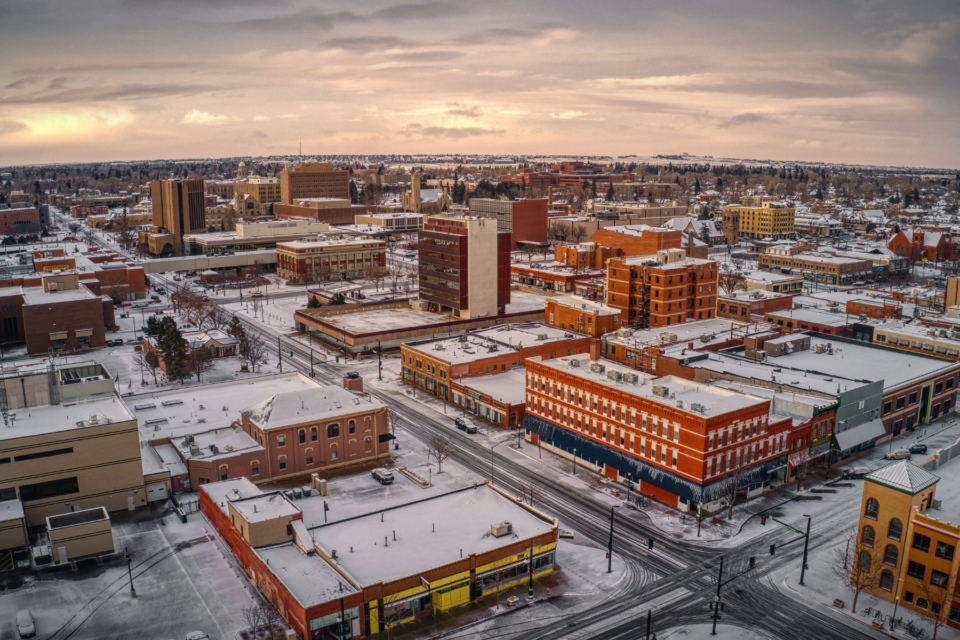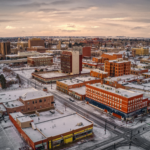The Solidified Seven: Governing Body set goals for 2022

On January 15th, 2022, the City of Cheyenne Governing Body met for a goal setting session to discuss their main objectives for 2022. Beginning with more than 100 goals submitted by all members, the five-hour discussion led to the formation of The Solidified Seven. The seven main goals agreed upon by the Governing Body for the next calendar year are (listed in alphabetical order):
- 15th Street Railroad Experience
- Annexing County Pockets
- Belvoir Ranch
- Gymnastics Building
- Homeless Issues
- Reed Avenue Corridor
- Surface Water Drainage
Once the seven goals were broadly identified, the Governing Body continued conversations to define each goal and its success.
“I can’t believe it’s been a year since our first goal setting work session. If I could use one word to describe the past year it would be gratitude. I’m thankful how well our Governing Body worked together and how we’ll continue that with new goals we’ve established,” stated Mayor Patrick Collins. “It’s important for us to establish these goals and collectively set aim on what’s key to our community’s sustainable growth, safety, and quality of life. These goals will take all of us: our Governing Body, City staff, and community members. Together we can accomplish these, and I look forward to the process.”
“I ran into a former Mayor recently in downtown. He looked at me, smiled, and said, ‘Some lofty goals y’all have this year’. I just smiled back and said, you know what, we’re gonna make them happen too. All he could say in return was ‘I hope so’. In speaking with him — he’s right — there are some lofty goals. Some of these goals were kicked down the road many years ago. Now it’s time to address them. With this council I’m impressed with their due diligence and political will to make these goals a top priority,” said Council President Scott Roybal.
Cheyenne’s esteemed railroad heritage is at the root of creating the 15th Street Railroad Experience. Positioned west of the Historic Depot along 15th Street, the area would be home to refurbished railcars; each serving as a site for downtown restaurants, shops, tourist attractions, and more.
“This will be great. It will bring in tourist dollars and bring train enthusiasts to town. When the steam engine goes, people line the tracks from here to Laramie. It’s amazing,” Roybal said of the proposed 15th Street Railroad Experience.
Currently, Visit Cheyenne serves as project manager and has hired an architect consultant to conduct a master plan. The City aims to move forward with a public process, including business and building owners in the area, along with identifying funding sources for the project. This year the City is striving to place rail cars on-site and begin the refurbishing process for each relocated railcar. The City held a work session regarding the 15th Street Railroad Experience on October 22, 2021. A link to that work session can be found on YouTube.
As Cheyenne grows, additional county pockets surrounded by City land emerge. This can prove problematic for public safety and coordination efforts between City and County first responders. In various locations across Cheyenne, City land is located on one side of the street, county land on the other thus creating a checkerboard of differentiating utility and first responder services. To alleviate this growing issue, the City will identify county pockets surrounded by 75 percent of City property along with identifying resources to assist residents wishing to update their property into the City. The Governing Body agreed to assess annexation throughout the area and across all three City wards. This goal will also identify City staff requirements and the costs associated with potential annexations.
Roybal added, “As our City gets bigger and bigger we really need to address this and have a consistent program to have County pockets brought into the City.”
The Belvoir Ranch, located 16 miles west of Cheyenne, was purchased by the City in 2003. The area consists of 18,800 acres of untapped recreational opportunities. The Belvoir Ranch is also the site of The Big Hole amassing 1,000 acres of rim property and 800 acres of spectacular red rock canyon scenery. Currently the only public access to the Big Hole is through Red Mountain Open Space trails in Colorado. Railroad underpasses and private property currently limit public access onto the land in Wyoming. A video tour of the Belvoir Ranch and The Big Hole can be found on YouTube. The Governing Body set a 2022 goal for public access on the property and get “boots and bikes on the ground”. The City will collaborate with Visit Cheyenne as a project coordinator and Wyoming State Parks to utilize their expertise and resources for the 18,800-acre property. A goal to utilize carbon capture for the ranch to receive input and improve the ranch’s resources and economics was also pinpointed.
“As you well know, we purchased the Belvoir Ranch nearly 20 years ago and we’re still chasing that,” Roybal added. “With this council, and this goal setting session, I think we will have bikes and boots on the ground by the end of this year.”
All but one measure on the 2021 Sixth Penny ballot passed. The lone proposition that narrowly failed, by 113 county-wide votes, was a new gymnasium and gymnastics facility for Cheyenne.
“On the sixth penny ballot, the gymnastics facility was the only proposition to fail county-wide. If you look at the data, City of Cheyenne residents voted in favor of the proposition. It was elsewhere around the county that voted it down,” said Roybal. “So, I think it’s gonna be us who has to build it. This year we’ll identify the property, identify the funds, and look to get it open.”
With the City’s current gymnastics facility soon to be demolished, the Governing Body has deemed the construction of a new building as one of their seven main goals in 2022. Moving forward, the City will identify a funding source for the project, implement design and construction documents, and work with Community Recreation & Events (CRE) personnel to develop staffing plans and associated costs. Adequate parking and potential plans for a second building to house indoor athletic courts were also associated to this goal by the Governing Body.
Addressing the City’s homeless issues is another goal for the upcoming calendar year. On September 17th, 2021, a work session was held on the topic. Video of the session can be found YouTube. The work session featured COMEA Shelter and Family Promise staff providing information to the Governing Body related to Cheyenne’s homeless status and potential collaborative efforts. One of those collaborative efforts was discussed during the goal setting session with the proposed purchase of a low-barrier shelter for the COMEA Shelter. In addition to prioritizing a low-barrier shelter, and solutions to those experiencing homelessness, the City will focus on deterring homeless camps often found under bridges and in parks. Discussion expanded to goals of collaborating with the Cheyenne Police Department (CPD) to deescalate aggressive homeless situations, comparing and evaluating yearly vandalism rates, and the placement of security cameras in locations where property vandalism has occurred.
“Since COVID we’re starting to see a lot more aggressiveness, vandalism, and things of that nature. We need to get a handle on that,” said Roybal.
The Reed Avenue Corridor, located in the West Edge District, was once a thriving railway business hub in the early 20th century. Over time, the use of rail service declined as other transportation options emerged. As a result, a once vibrant and busy section of Cheyenne became stagnate and now sits poised for growth and urban redevelopment. Like the Belvoir Ranch, railroad tracks are also a barrier to the Reed Avenue Corridor’s redevelopment. Currently, the Burlington Northern Santa Fe (BNSF) railroad holds right-of-way access in the area which has halted the City’s vision of placing new businesses, restaurants, breweries, and residential buildings along the corridor. For 2022, the Governing Body has a goal to resolve right-of-way issues with BNSF and/or find viable alternatives for a path forward. This would also position the City to connect its ever-expanding greenway system to the area in the future. Resolving right-of-way issues, along with designating a project manager, have been deemed goals for this underutilized area of Cheyenne to spur redevelopment and become a new economic driver for the City. In June of 2021, the City’s Governing Body adopted an Urban Use Overlay district to pave the way for the rezoning of parts of the West Edge District to mixed-use. The adoption will help promote the integration of new development and redevelopment projects in the area that strengthens the West Edge District’s identity and use. The rezoning to mixed-use is expected to be complete in early 2022. Substantial private investments have also spurred redevelopment by bringing new businesses, restaurants, breweries, and residential buildings to the district. The West Edge has outpaced Laramie County in terms of growth, contributing over $1.08 million in private investments. The West Edge District encompasses approximately 30-plus square blocks to the west of downtown. It is bound by 26th Street to the north, Union Pacific railroad tracks to the south, Missile Drive to the west, and Central Avenue to the east.
“With the Reed Avenue Corridor, we have the money. It’s just been a matter of focus,” said Roybal.
Surface water drainage is the last of the seven main goals established by the Governing Body for 2022. Longtime Cheyenne residents can recall the devastating flood of 1985 that claimed 12 lives and caused over $60 million in property damage. Several flood mitigation and drainage projects have taken place since the 1985 flood but it remains an evolving issue. As the City grows, additional impervious surfaces such as concrete and asphalt continuously alter natural water absorption patterns and water flow.
“Surface water drainage is something we’ve needed for the past 120 years. But again, it’s a hard and lofty goal so it’s going to take some political will and some due diligence,” said Roybal.
For 2022, the City will propose drafting a surface water mitigation program through City ordinance, identify scope of work, and configure an appropriate fee structure for residential and commercial properties. As part of this goal, the City will collaborate with other Wyoming communities who have established similar programs and update the City’s existing surface water drainage plan.
2022 marked the second consecutive year of goal setting sessions for Mayor Collins and the City Council. In January 2021, at their initial goal setting work session, the Governing Body pinned down multiple goals for the calendar year.
“I’m proud of the way our Governing Body worked together and the goals we accomplished last year. We set those goals and accomplished all but one of them, which was the surface water mitigation problem. Over the past year, we’ve continued working on that unresolved problem and I think we now have the ‘secret sauce’ for its solution. It remains a goal this year and we look forward to accomplishing it,” said Mayor Collins.
The formation of an Urban Renewal Authority (URA) Board was one of those 2021 goals that came to fruition, paving a way to redevelop blighted properties such as the former Hitching Post Inn. The URA’s implementation proved to be the missing ingredient to redevelop this prominent western entryway location that will soon transform into new hotels, a bank, coffee shop, a restaurant, and more. Utilizing the URA has set a blueprint for the City moving forward with other blighted properties in Cheyenne.
The 2021 Sixth Penny ballot was a goal set out by the Governing Body and resulted in 13 of 14 propositions passing in the county-wide election last November. The successful ballot allotted $128 million out of possible $130 million for county-wide improvements to public safety, roads, infrastructure, and community enhancements. The City worked with Laramie County officials and elected officials from Pine Bluffs, Burns, and Albin to construct the ballot. Voter approved propositions will help a growing Cheyenne with the addition of new fire stations and fleet replacements, greenway expansion and maintenance, road maintenance projects, continued air service, investments into downtown infrastructure, and match grant opportunities to name a few.
Last year, the Governing Body set forth a balanced budget, reinstated employee longevity pay, and approved a $1.50/hour pay raise for all employees to combat rising inflation costs. In addition to the URA board, the City created the Affordable Housing Task Force, Community Technology Advisory Council, and the Innovation and Entrepreneur Advisory Council. Consisting of community volunteers, these boards address pressing needs and recommend solutions specific to Cheyenne. The City’s goal of transparency continued through multiple public work sessions to inform and educate the Governing Body and community members on numerous topics. In total, the City held 28 work sessions in 2021. These work sessions have been made available to watch live online through Zoom, Facebook, and YouTube and remain available to watch on-demand.
A successful negotiation with the local fire union was one of the first goals the Governing Body accomplished in 2021. The negotiations resulted in a signed contract including more money for union members and additional management rights to the City for the first time in years. The 2022 fire union negotiations will commence later this month.
A goal to implement a solution to Thomas Heights seasonal flooding has made progress in the past calendar year. The goal of flood mitigation has advanced to geo-technical studies, surveying the area, and is now at the stage of an engineering solution to divert seasonal flooding into a nearby tributary.
For more information about the City of Cheyenne, visit www.cheyennecity.org.


